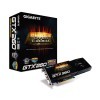- Qualcomm Launches Snapdragon 4 Gen 2 Mobile Platform
- AMD Launches Ryzen PRO 7000 Series Mobile & Desktop Platform
- Intel Launches Sleek Single-Slot Arc Pro A60 Workstation Graphics Card
- NVIDIA Announces Latest Ada Lovelace Additions: GeForce RTX 4060 Ti & RTX 4060
- Maxon Redshift With AMD Radeon GPU Rendering Support Now Available
Gigabyte GeForce GTX 260 Super Overclock

NVIDIA’s GeForce GTX 260 is not a new card. In fact, it’s been available for over a year in its 216 Core form. So is it even worth a look at today? Where Gigabyte’s “Super Overclock” version is concerned, yes. Although it costs less than a stock GTX 275, this new card beat it out in almost every single game and setting we put it through.
Page 11 – Overclocking the GTX 260 Super Overclock
Before tackling our overclocking results, let’s first clear up what we consider to be a real overclock and how we go about achieving it. If you read our processor reviews, you might already be aware that we don’t care too much for an unstable overclock. It might look good on paper, but if it’s not stable, then it won’t be used. Very few people purchase a new GPU for the sole purpose of finding the maximum overclock, which is why we focus on finding what’s stable and usable.
To find the max stable overclock on an ATI card, we stick to using ATI’s Catalyst Overdrive tool. Compared to what’s available on the NVIDIA side, it’s quite limited in the top-end, but it’s the most robust and simplest solution to use. For NVIDIA, we use EVGA’s Precision, which allows us to reach heights that are in no way sane – a good thing.
Once we find what we believe might be a stable overclock, the card is put through 30 minutes of torture with the help of OCCT 3.0’s GPU stress-test, which we find to push any graphics card harder than any other stress-tester we’ve ever used. If the card passes there, we then further verify by running the card through a 2x run of 3DMark Vantage’s Extreme setting. Finally, games are quickly loaded and tested out to assure we haven’t introduced any side-effects.
If all these tests pass without issue, we consider the overclock to be stable.
Overclocking Gigabyte’s GeForce GTX 260 Super Overclock
The Super Overclock isn’t only Gigabyte’s highest-clocked GTX 260, but it’s the highest-clocked GTX 260 I’ve found anywhere on the web being sold. There are a few others that come close, but Gigabyte has really pushed the bar high. With such high clocks to begin with, I wasn’t expecting too much more juice to be pushed out of it, but I was a little surprised, as 720MHz Core, 1550MHz Shader and 2600MHz Memory proved to be completely stable.
Oddly enough, the card seemed completely stable at 730/1600/2700, and it even managed to pass through OCCT 3.0 for a full hour without an issue. But, the major overclock wasn’t a match for real gameplay, as games such as Crysis would crash within five minutes of playing. So, with your own card, you may very well be able to push the clocks higher, but for me, what’s listed above is all I could manage while retaining full stability.


As you can see, the differences with the overclocked settings isn’t too staggering. Rather, it’s expected, and you have to ask yourself if it’s really worth the time, extra heat and additional stress on the card for so little gain. Personally, I’d say no. This card is super-fast as is.
Support our efforts! With ad revenue at an all-time low for written websites, we're relying more than ever on reader support to help us continue putting so much effort into this type of content. You can support us by becoming a Patron, or by using our Amazon shopping affiliate links listed through our articles. Thanks for your support!





